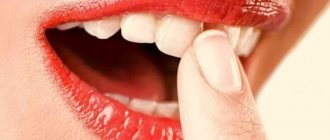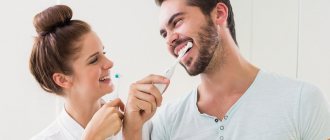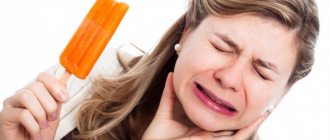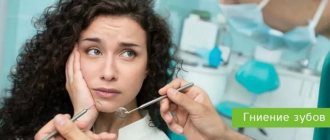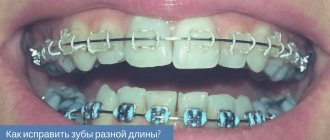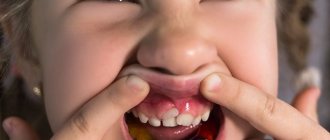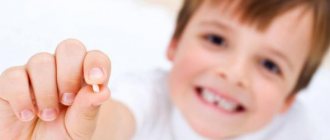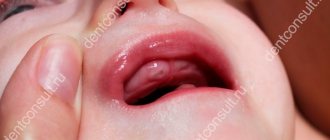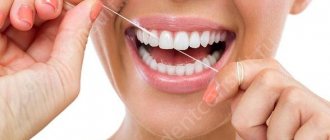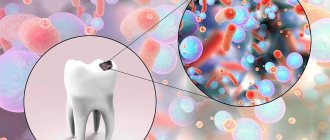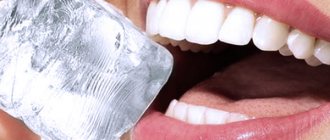There are a lot of questions about brushing your teeth, so let’s go over the main ones:
- What happens if you don't brush your teeth?
- Is it possible to brush your teeth rarely, but go to the dentist from time to time so that he can “powerfully clean” them for you?
- How is teeth cleaning performed in dentistry?
- Why do the Swiss brush their teeth without toothpaste at all?
- Does chewing gum work?
- Which brushes to choose and how? What about electric ones?
- Is it true that you should throw away the brush when at least one lint deviates from the vertical?
- Why do we need tongue scrapers, interdental brushes, dental floss and everything else?
- Does an irrigator replace brushing your teeth?
- Is mouthwash a good topic?
- When is it more important to brush your teeth - in the morning or in the evening?
- How does an IT professional differ from the average patient's oral health history?
Why brush your teeth at all? What happens if you don't touch them?
The oral cavity is the site of an ongoing battle between approximately 700 species of microflora.
Saliva is one of the most active fluids in the body. On the one hand, it must neutralize biological threats from the outside world, on the other, pre-process food, and on the third, protect teeth. From the point of view of evolutionary biodesign, the problem is solved very well if you eat what evolutionary biodesign offers from the outside world. For example, apples, large animals with tough meat, then unripe wild pears, carrots, and so on. Hard food cleans teeth perfectly without your help. Several tens of thousands of years ago, something went wrong, and man learned to cook food over fire. This gave rise to the first problems, but at that time they were not very significant, since in the light of the development of medicine and the lack of antibiotics, teeth were not the most important problem. But already in the twentieth century, when fast food, forced high-carbohydrate diets and soft, inconsistent food entered the masses, real difficulties began.
Plaque is a biofilm of bacteria that sticks to your teeth and does its best to protect itself from aggressive saliva and other cleaning methods. In this regard, bacteria are greatly helped by adhesive microfragments of food, which remain in the form of such glue on the teeth. For example, crumbly cookies or pizza dough combined with dead cells create a good bioglue. Bacteria land on it and begin to colonize your tooth. Their goal is to get inside and set up a base there. We call this caries. Most often, developed caries is just amphora-shaped: a small entrance hole and a sea of destruction inside the tooth.
This is how the patient comes:
Here is hidden caries revealed:
And here is the end of the therapist’s work:
Hidden caries can, in principle, be detected by radiography and transillumination.
If you remove this biofilm in time, there will be no caries. But it is quite strong, so either a strong antiseptic is needed (the same alcohol, which also harms other parts of the system, starting with the oral cavity), or mechanical treatment (with an apple or a toothbrush). A large amount of saliva partially washes away the films, but not all of them: for example, they remain at contact points and under the edge of the gums.
Several layers of biofilm form a calculus - tartar. This is a pretty disgusting reinforcement of bacteria. It is disgusting with its unique smell and taste (which your partner often feels with every kiss). But from a medical point of view, this is not the main thing. The main thing is that tartar still puts pressure on the gums and impedes the blood supply to the gums, creating complex inflammations. Well, no one ruled out caries. Imagine that several grains of sand have stuck into your hand, and they stick out there for months, gradually increasing in size. Tartars are about as unpleasant, but due to the nature of their innervation, you almost don’t feel them.
So, if you don’t brush your teeth, a biofilm will form very quickly. And if you don’t touch the biofilm, a calculus forms, which triggers many unpleasant processes. It is an accepted medical practice to brush your teeth after breakfast and dinner.
How in ancient times our ancestors managed without regular cleaning
Before the advent of cleansers, pastes, balms and rinses, people did not care too much about the condition and appearance of their smile. To remove plaque, our ancestors used dried herbs mixed with chalk and charcoal. For rinsing, decoctions of chamomile, oak bark and propolis tincture were prepared. For fresh breath, they chewed tree resin and mint leaves.
A clear example of what happens if plaque is not cleared for years was demonstrated by the Chinese Emperor Mao Tse Tung. His decision to abandon hygiene entirely was based on observations of wild animals. The leader thought that if their fangs did not suffer in any way without cleaning, then people did not need it either. But over time, his smile noticeably turned yellow, a foul odor appeared, and his incisors and molars began to rot and fall out. No one from the inner circle dared to reprimand their leader.
Chinese Emperor Mao Zedong Never Brushed His Teeth
We need to understand that our diet is very different from the food that animals are used to. Now we have at our disposal a lot of tasty, but often harmful dishes, with chemical additives, dyes and carcinogens. Many smoke, drink coffee and strong teas. All this has direct consequences for the appearance and health of the enamel. I don’t want to brush my teeth, because animals don’t brush them – in our modern world this is not an argument. If you want to keep your smile beautiful and healthy, you will have to maintain hygiene.
When is it more important to brush your teeth - in the morning or in the evening?
It may seem that brushing your teeth in the morning and at night is equally important.
But no, evening cleansing is much more important. At night, your body produces less saliva (this is one of the reasons why your mouth is dry in the morning). Less saliva on your teeth means less protection for them. Less protection means faster biofilm formation. That is, if you brush your teeth in the morning so that your breath does not smell when talking, then in the evening you need to brush your teeth for medical reasons. Most teeth brushing techniques suggest that evening brushing should be longer than morning brushing.
What does proper oral hygiene give us?
- Prevention of caries.
Microbes and food particles stuck in the interdental spaces negatively affect the enamel, gradually destroying it. - Elimination of unpleasant odor.
The gases released by bacteria have a very unpleasant odor. In addition, food particles remaining in the mouth begin to decompose over time. As a result, bad breath appears, and thorough brushing of teeth perfectly freshens breath. - Remineralization of enamel.
Using strengthening toothpastes with a mineralizing effect will help strengthen the enamel and make teeth less susceptible to acid attack. - Healing and soft tissue massage.
The stability of teeth directly depends on the condition of the gums, and daily brushing prevents inflammatory processes in soft tissues and improves the overall condition of the oral cavity. - Prevention of diseases.
Microorganisms living in the oral cavity can cause ENT diseases, such as tonsillitis. Poor hygiene will contribute to this.
Is it possible to independently assess areas of biological damage?
Yes, you can. To do this, you need to buy either Curaprox, Dynal tablets, or Curaprox, PresiDENT liquid at your nearest pharmacy. The tablets are chewed to a cheerful foam and spat out. Considering that you need to carefully and thoughtfully read the instructions to the end, it is better to buy a liquid; it is applied with a special swab or cotton swab. It will be more reliable. But if you have not had hygiene for the last two to three months, then it is better to do it on Friday evening. In fact, it washes off almost immediately, but there is a chance that particularly severe lesions will be stained for about 50 hours. This happens quite rarely and with poor hygiene, but it is a matter of chance.
What happens during dental hygiene?
First, the hygienist looks at the size of the stones.
If there are very large ones, then we break them up with ultrasound. Next, we work with the plaque manually using rotating brushes, rubber bands and paste. If you need to get under the gum, there are curette hooks that can be used to clean difficult areas and smooth the surface of the roots so that rotting food does not linger there. Then each gap between the teeth is treated with floss and fine sandpaper. The teeth are then polished. The next stage is strengthening: a disposable mouthguard with a remineralizing solution is placed on the teeth. It then discusses how best to brush your teeth in the future. Then there are two approaches: “industrial” and “archaeological”. If you see sandblasting on soda, then in front of you is a hygienist who wants to do it quickly and powerfully. However, due to the design features of this equipment, it is very difficult to ensure a balance of efficiency and safety, so we consider this approach not the best from the point of view of its relationship to the tissues of the oral cavity (the rough surface of the tooth after a large abrasive gives greater adhesion to sticky food, gum damage is not uncommon). Manufacturing companies are trying to solve this problem, but for now our choice is mechanical contact cleaning.
During cleaning, various chemical agents and “soft” abrasives can be used. If there is inflammation of the gums (which is often associated with “blockages” of stones), then treatment with special antiseptics and agents may be necessary to relieve inflammation. In this case, the appointment is often divided into two: first, the stones above the gum line are removed, then five to seven days pass until the inflammation caused by them subsides, and then the stones below can be worked relatively safely. If you do everything in one go, it won’t be very beautiful: there will be blood in all directions. It’s not that we feel sorry for doing this, it’s just that it prevents us from properly assessing the results of the work inside this bloody mess. That's why we love it when it's clean, the patient doesn't break out and doesn't panic. Gingivitis starting from the middle stage = two doses a week apart.
The procedure itself is painless, but sometimes patients feel ticklish. Sometimes grinding an instrument against your teeth causes unpleasant emotions. There is no problem doing everything under local anesthesia: this is exactly the case when you don’t need to be afraid to ask for it.
Hygiene is done before any more or less serious intervention, since it allows for correct diagnosis later and correctly taking into account the shape of the teeth. Well, the fewer dangerous bacteria there are during invasive procedures near the field, the better.
The Importance of Brushing Your Teeth
There is a myth that a simple apple or carrot can replace a toothbrush and toothpaste. And really solid food can remove plaque from the vestibular and lingual surfaces .
However, these are not the only surfaces of the oral cavity; plaque also accumulates in the interdental spaces and other places .
Attention! Any plant food contains sugars, which create favorable conditions for the growth of bacteria, and they are the cause of oral diseases.
If plaque is not removed, over time it will turn into tartar . And that, in turn, leads to diseases of the teeth and gums, the appearance of bad breath and bleeding gums.
The stone consists of proteins, epithelial cells, polysaccharides and microorganisms. It is to prevent the formation of tartar that you need to brush your teeth at least twice a day.
The brush removes from sixty to eighty percent of plaque, so it is also important to use dental floss, brushes , irrigator and periodically undergo ultrasonic cleaning or Air Flow, and for a more beautiful smile, teeth whitening.
It’s better to wash your hair rarely than to brush your teeth rarely, because the oral cavity is more susceptible to infections than the rest of the body.
How to brush your teeth correctly?
A colleague of mine recently wrote about the characteristic “programmer teeth”.
About half of the problems in these cases are associated with insufficient salivation of the oral cavity: this is a completely predictable consequence of night work, stressful focus on the task and various problems with eating. Since I have very little faith that after reading this someone will suddenly start eating right or change their daily routine, let’s tell you how to properly brush your teeth using the Swiss method. It is most suitable for those who have a busy schedule, stress and poor nutrition. That is, for all adults in large cities. It's called the BASS technique (more precisely, the advanced Bass teeth brushing technique). It is one of about two dozen techniques available. Note that we still don't know which teeth cleaning technique is best out of all the different ones out there. If you are interested, this issue was raised in Nature: here is an analysis of recommendations from various sources, textbooks and a selection of studies. The result is that the Bass technique is too complicated for children, but for adults it gives the best results. Moreover, all studies that numerically confirm this were carried out over a fairly short observation period.
Sorry for the compression, this is the original image quality from a study of 180 healthy children.
Blue was and became - this is your usual horizontal brushing, red - circular with closed teeth, green - according to Bass. Here is another study with a longer follow-up period. This is partly due to the fact that it is difficult to follow patients and stand over them every time they brush their teeth. Nevertheless, this method is currently one of the best, judging by scientific data and practice. Here's what to do:
1. Buy a soft toothbrush with the most bristles. The shape is strictly straight (both the handle and the fleecy part without bends or protrusions). You still won’t be able to do anything better with a hard or medium-hard brush, but a soft one cleans much better and without damage: we will work on the border with the gum.
I recommend Curaprox ultrasoft 5460, Revyline, TePe brushes, but you can choose any similar ones.
2. Take the brush like a handle (not in a fist) and place it at a 45-degree angle to the gum vertically, so that the bristles go under the edge of the gum. You will feel it. Half of the brush should be on the crown of the tooth, half on the gum. Next, start moving the brush so that you get such long ovals. Gradually work your way across all teeth from the front, working at the edge of the gum.
Do not move the brush with your elbow or forearm, only with your hand. You should get very soft smooth movements.
3. Brush the inside of your teeth in the same way, but hold the brush vertically.
4. After this, make the usual horizontal movements along the edges of the teeth and their frontal surfaces.
The procedure is slower than usual haphazard cleaning, since you need to go over all the teeth very carefully at the edge with the gum. In the morning it takes three minutes, in the evening - more than five minutes. In Switzerland, people brush their teeth for seven to ten minutes, leaving the bathroom with a brush without toothpaste. This is a very good practice, and I recommend it: just take a brush and sit down to watch YouTube or do something else and work gently along the edge of the gum. The point of the method is not only that you can do something else while brushing your teeth (fortunately there is no toothpaste), but also that you do not see your reflection. When you control a brush based on visual cues, it always dramatically reduces the quality of brushing compared to brushing without a mirror, because different sensory systems are involved. And sensations are more important than vision here.
Tooth pulpitis - what is it?
Microorganisms + the toxins they release begin to penetrate into the dental pulp from the area damaged by caries. The body's response is increased blood flow in the pulp, increased pressure on the nerve fibers.
Acute pulpitis
It is characterized by acute toothache that occurs under the influence of cold/hot liquid or air. As soon as the irritant stops acting, the pain disappears. Consequences: lack of treatment leads to exacerbation of the disease and the occurrence of purulent pulpitis.
Purulent pulpitis
The disease is characterized by the presence of a purulent focus, which is located in the tooth cavity. The person begins to experience severe, unbearable pain, intensifying at night. Painful sensations are transmitted to the temporal region, ear or eye socket. Consequences: can lead to necrosis (death) of the pulp.
Chronic pulpitis
Untreated acute pulpitis leads to the development of a chronic condition. With chronic pulpitis, severe throbbing pain occurs when exposed to an irritant. As soon as the irritant goes away, the painful sensations gradually decrease. Chronic pulpitis requires prompt treatment, otherwise... Consequences : there is a high probability of a complication - periodontitis .
Is it true that you should throw away the brush when at least one lint deviates from the vertical?
Yes, if the bristles on your brush are no longer vertical, it is better to change it.
Typically, brushes are changed about once a month, but high-quality options from the recommendations above can be changed once every three months with the right manual skills. It is also very important to change your brush after hygiene at the dentist: they “restart” the microbiota of your oral cavity, and it is not very good to introduce old pathogenic ones from an old brush.
Pharmacies sell disposable toothbrushes with dry granules and beneficial enzymes. I recommend keeping one in your bag; it's a great option if you find yourself wanting to look and smell perfect.
Why do we need tongue scrapers, interdental brushes, dental floss and everything else?
A tongue scraper is very important because the tongue needs to be cleaned too. You can do this with a separate brush, but a scraper is much more convenient and effective. I recommend double scrapers, here are a couple of examples: Curaprox double and TePe. It is better to use the scraper before the main cleaning, passing over the tongue literally three to four times.
Dental floss is not recommended at this time. More precisely, it is very good for cleaning fiber from meat after a restaurant (and better than not having it at all), but it is bad if you do not know how to use it correctly. But almost no one knows how: you can’t touch your gums with it. Therefore, a more modern approach is interdental brushes. They look like this:
As you can see, they are different colors for different intervals. They need to be selected with a doctor using a special probe, which is inserted between specific pairs of teeth. It’s better not to do this on your own. To summarize: it is better to forget about brushes, as well as about thread, until your doctor directly advises you to do so.
Mouthwash is good during the day after meals, as long as it does not contain alcohol. It works better with alcohol, but damages teeth and soft tissues (primarily mucous membranes). Without alcohol it is worse and is not suitable as a replacement for a full-fledged cleaning, that is, it is better to use it only during the day if you need to get rid of odor or clean your mouth after eating.
There are also foams like Water Dent - they restore the environment to a slightly alkaline environment, which is much better than the acidic environment after a meal (and especially after coffee). Some mouthwashes work the same way.
Basic rules for maintaining hygiene - expert advice
To maintain oral hygiene, it is enough to follow simple basic rules. Here's what dental and hygiene experts recommend in this regard:
- Cleaning twice a day is the first and main rule. Moreover, you should use an individually selected brush and paste, and in this regard it is better to consult your dentist personally,
- use floss and rinse your mouth every time after eating - to quickly remove food debris,
- limit your consumption of sweets, especially before bed - sugar and simple carbohydrates pose an increased risk to enamel health,
- clean your tongue - it is on its surface that the most bacteria are concentrated, which become a source of unpleasant odor. To remove plaque from the tongue, you can use the reverse ribbed surface of the brush or a special scraper.
Proper oral hygiene will help maintain healthy teeth for a long time.
It is also important to visit the dentist’s office at least twice a year - for preventive maintenance and professional procedures. hygiene. Even with regular quality care, bacteria remain in the mouth and lead to the formation of deposits. Only a doctor can remove them, using hand tools, ultrasound, laser or sandblasting. Following all of the above recommendations will help you maintain a beautiful smile for many years.
1Grudyanov A.I., Ovchinnikova V.V. Inflammatory periodontal diseases as a risk factor for the development of pathology of the cardiovascular system, 2007.
Does the irrigator work?
A toothbrush removes about 70% of biofoci. The rest are located where mechanically cannot be reached, for example, at contact points. So yes, the irrigator complements regular teeth cleaning very well. If you can, use it every time. But just don’t take stationary ones that require connection to a household power supply. Practice shows that my patients do not use these because of the difficulty of turning them on in the bathroom. It’s better to use mobile phones with batteries, they are much simpler and always at hand near the sink.
Which pasta to choose?
Any with low abrasiveness is suitable.
Pastes with calcium work, but only if the paste is left on the teeth for a long time. I do not recommend whitening toothpastes, toothpastes for smokers or coffee lovers. Look at the abrasiveness index, the best options are around RDA 50–70 units. In the morning you can use antibacterial, but in the evening - only regular. I recommend pastes such as Biorepair Night, Apadent, ROCS “Active Calcium”, Curaprox. I don’t particularly recommend the Russian versions of Colgate and Blendamed: they have changes relative to the foreign composition, which makes the environment more aggressive. Milk and cottage cheese do not affect teeth (calcium from them almost does not enter the enamel). Pastes have little effect, but with 10-minute cleanings the results are noticeable. Usually, when a patient has problems with calcium, special gels are prescribed in courses of two weeks every three months.
A couple of links to research.
Which toothpaste to choose
Since the choice of toothpaste should be made taking into account all the characteristics of the teeth of each individual patient, it is recommended that you contact your dentist directly with this question.
Doctors at the Apex dental clinic always meet patients halfway and inform interested parties in detail about which toothbrush and toothpaste they should choose.
Today, pharmaceutical companies and other well-known toothpaste brands offer customers a wide range of products, but not every product can boast of its own characteristics.
In this regard, we once again emphasize the importance of resolving this issue together with the attending dentist. Only he will be able to make a truly correct decision, and only he will properly analyze all the components included in the toothpaste.
Is it true that dentists don’t want to teach us how to brush our teeth?
It may seem that the dentist has a vested interest in you brushing your teeth incorrectly.
Because if you teach it correctly, you won’t come back with caries or without a tooth at all. There are two exceptions:
- Hygienists who want to help the patient. This is either an ordinary human desire to do well, or the basis of the clinic’s work: good service is noticeable, and such a clinic is trusted much more (that is, they return much more often, and if a patient has been with the clinic for 10 years, then sooner or later he will statistically need expensive services) .
- And manufacturers of paste brushes and irrigators understand that the right set of consumables and instruments in the patient’s hands brings them quite a lot, so they try to train people in the correct processes, including through clinic hygienists.
We created the clinic as a way to make money at the cutting edge of applied science, but very quickly clients began telling their friends about us as one of the most caring dentistry in Moscow.
We were counting on “the most technically advanced”, but that was also nothing. I hope that “the most caring” contains my contribution, because I explain in great detail and detail how to avoid getting into the chair next time. And with me, you can practice brushing your teeth separately from the appointment: a hygiene lesson lasts 40–60 minutes, and the price includes the necessary set of brushes and brushes. PS If you come to our clinics, then say that you are from Habr, there will be a 5% discount.
Should baby teeth be brushed?
The answer is clear - it is necessary. Healthy primary teeth are a reliable guarantee of healthy permanent teeth .
You need to start cleaning your mouth from the first appearance, because, firstly, it guarantees excellent oral health, and secondly, it forms a habit. Oral hygiene left without due attention at a tender age can lead a child to the dentist's chair, where multiple caries will need to be treated under general anesthesia. Even if a child was lucky enough to be born with natural teeth, brushing his teeth is still necessary, because it will be more difficult to develop this habit at an older age .
In addition, sometimes the absence of problems can only be an appearance.
For your information! Prevention of oral problems, starting from the first teeth, is much less painful than their treatment.
